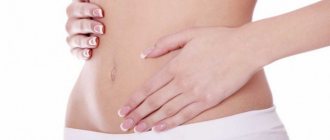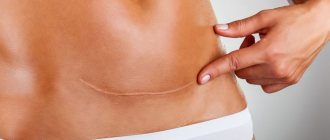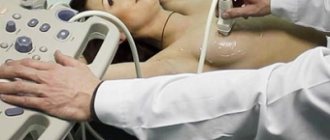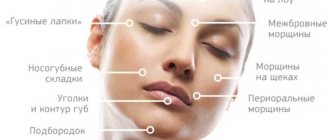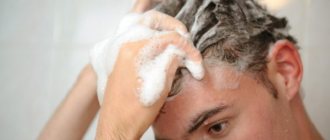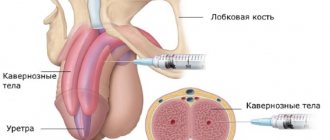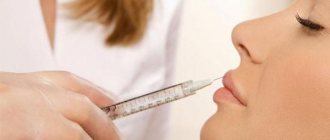Vaginal scarring is a fairly common occurrence. Damage to the vagina can occur in different situations, primarily during childbirth, during an abortion, or due to an inflammatory process. Simple scratches and cracks usually heal quickly and without consequences, but only if the wound has not become infected and the inflammatory process has not begun.
Healing of tears and cuts occurs much more slowly and most often with the formation of scars. If a woman’s vaginal tissues do not have a sufficient degree of elasticity, then when a child passes through them they can easily be injured. In this case, ruptures are formed due to strong stretching. The vaginal tissues cannot cope with the forces acting on them during the passage of the child.
If there is a threat of rupture, doctors decide to make a perineal incision. In this case, the consequences of severe muscle strain can be minimized. After the baby is born, the tears are sutured. But even in this case, when applying sutures it is rarely possible to avoid the formation of scars.
Sutures in the vagina are placed using catgut. They try to apply self-absorbing sutures to the vagina after childbirth, so that the woman does not have to see a doctor for removal. Stronger sutures are needed for serious tears. They are removed on the sixth day after suturing the wounds.
In the place where the vaginal tissue is replaced by scar tissue, blood circulation is disrupted, and various types of lumps and lumps appear. All these changes can result in unpleasant sensations for a woman during sexual intercourse. Vaginal injuries can occur not only during childbirth. With a high degree of dryness of the vaginal mucosa, the integrity of the organ can be obtained during sexual intercourse.
What determines the condition of the perineum
How the perineum will look after childbirth depends on many factors:
- duration of labor;
- the presence of chronic infectious processes in the pelvis;
- woman's age;
- degree of elasticity of perineal tissue;
- baby's head size.
Let us examine in more detail what changes in the appearance of the perineum a woman may encounter after natural childbirth.
Physiological changes in the vagina
The vagina is a tube-shaped sexual organ, the structure of which consists of elastic muscles. It is located in the small pelvis. The organ can vary in length: in a normal (calm) state its size is 10 cm, at the time of sexual arousal it increases to 15 cm.
It is a mistake to believe that the size of the vagina depends on the woman’s height. In reality, the parameters of the sexual organ depend only on the structure of the internal organs of the abdominal cavity, as well as their location.
does not significantly change its shape after childbirth Some women may feel that their penis becomes less elastic and stretched after having a baby. The first time after delivery, the organ’s shape is transformed, but after a certain period (recovery period), all parameters and dimensions of the vagina return to normal.
Vulva color change
During pregnancy, under the influence of hormonal changes, so-called hyperpigmentation occurs. At this time, the skin in the area of the labia and anus may darken significantly. Also, under the influence of hormones, nipples darken, and pigment spots may even appear on the face and body.
There is no need to be alarmed when dark skin is discovered on the perineum after childbirth. Gradually, as the balance of hormones returns to normal, this pigmentation will disappear.
How to reduce the risk of rupture?
There are ways you can reduce the risk of ruptures.
Readiness for childbirth
During pregnancy, it is important that the expectant mother undergoes preparation for childbirth: this can be literature, courses, you can look at photos of breathing rules, advice from mothers who have given birth, etc. After such information, the woman begins to be less afraid, since she can control the situation.
If you have attended courses for expectant mothers, the woman during childbirth will be ready for contractions and pushing, and will choose the optimal position and breathing rhythm for herself. This attitude will make childbirth more natural, which will reduce the risk of surgery.
Massage
To improve the elasticity of the perineal tissue during childbirth, you need to go for a massage or do it yourself, at least 2 times a week. The course should begin in the last month of pregnancy. The massage is carried out in the evening after taking a shower; it is important to maintain hygiene so as not to cause an infection. You can use oil during the procedure. You cannot use oils with fragrances, because... they can cause allergies.
Massage technique: insert your fingers shallowly into the vagina and massage with light pressing movements towards the anus, this is the area most often susceptible to ruptures. The procedure lasts no more than 5 minutes. If the woman is not embarrassed, her partner can perform the procedure.
Kegel exercises
Kegel exercises help improve tissue elasticity and strengthen the perineum, which will greatly facilitate the process during childbirth, and also help you recover faster after. The exercises involve contracting the muscles of the vagina and anus at different rates.
How many times should you do the exercises? For the first time, you can start with 10 contractions, performing 4 times a day, every day you need to increase the number of times.
The convenience of this technique is that it can be performed anywhere. Many people have problems doing it at first; it seems like they can’t do it, but daily training will improve the technique. The main thing is not to stop studying.
Hematomas
Hematoma is an accumulation of blood in soft tissues. During childbirth, the perineum is subjected to prolonged strong compression by the baby's head, especially if the fetus is large. In this case, significant hematomas may occur at the site of pressure, which outwardly look like bruises.
Normally, blood in hematomas resolves on its own within 1–2 weeks. If a lump appears at the site of the bruise, and when you press on it you feel significant pain, then you need to visit a gynecologist.
A hematoma can be complicated by infection if basic hygiene rules are not followed.
Unusual smell
In the first 6–8 weeks after birth, lochia may emerge from the uterine cavity. This postpartum discharge is of a sanguineous nature, it is mucous and may have a mild odor. Lochia is a sign of healing of the uterine cavity.
If suddenly the discharge from the genital tract begins to acquire a strong, unpleasant odor, you should immediately notify your doctor.
Bad-smelling discharge may also be accompanied by the following symptoms:
- change in color of discharge - up to yellow-green color;
- pain in the lower abdomen;
- increased urination;
- increase in body temperature.
All these signs are characteristic of the development of a genital tract infection, which is treated with antibiotics as prescribed by a doctor.
To eliminate the possibility of developing an infection in the postpartum period, you must follow all the doctor’s instructions: maintaining hygiene, lack of sexual activity in the first weeks after childbirth, wearing underwear made from natural materials, and timely replacement of pads.
Breaks
Soft tissue ruptures often occur during childbirth. They can be of varying degrees, sizes and depths. It is important that qualified medical personnel attend the birth. After all, it is the midwife during childbirth, when she sees that the threat of rupture is extremely high, who makes an incision in the perineum - an episiotomy.
Why is this necessary? An even incision made with a sharp surgical instrument heals faster and with minimal risk of complications.
After the baby is born, the doctor carefully examines the genital tract. If there are tears or cuts, sutures are necessary. For this purpose, as a rule, natural absorbable suture materials are used.
The future appearance of the woman’s perineum depends on the care of the specialist and how correctly he compares all the tissues.
What can help avoid trauma during childbirth:
- correct behavior during contractions and pushing;
- the position of the woman in labor, when there is no strong pressure on the perineum (half-sitting);
- adequate assistance from medical personnel;
- mother's confidence during childbirth.
What to do if ruptures or incisions during childbirth could not be avoided? The most important thing is adequate hygiene of the genital tract. For the first couple of weeks, it is recommended to wash yourself after each trip to the toilet, and then blot your perineum with a soft towel. Avoid putting stress on the seam - do not sit on a hard surface, do not squat for a long time, avoid rubbing with linen.
Problems that may arise with a crotch seam:
- discomfort;
- redness of the tear area;
- compaction of surrounding tissues;
- increased body temperature;
- bleeding from the suture.
All this indicates the presence of problems and requires urgent medical attention. In some cases, treatment will involve removing the old threads and re-stitching.
Treatment
The most effective way to treat scar formation in the vagina is to use a laser. Before the advent of this method, scar tissue was excised in the usual way.
Why is it necessary to treat cicatricial changes in the vagina? A scar in the vagina is formed as a result of wound healing by attracting a large number of collagen fibers; in this case, this area of the organ loses the properties inherent in healthy tissue areas. Rough scars can severely deform the perineal tissue.
For this reason, the process of urination and defecation may be difficult. Due to scars, the passage into the vagina can be greatly narrowed, and this already affects the quality of sexual life, to the point that sexual intercourse becomes impossible.
In this case, you need to seek help from a gynecologist; conservative treatment will not give the desired result. There are a number of drugs that can affect scars, but given the specific location of scar tissue, the result from using the same Solcoseryl will be minimal.
Laser
When using modern methods of treating scar tissue, the scar is excised, and then layer-by-layer tissue restoration occurs. In particularly difficult cases, they resort to vaginal plastic surgery using a skin-fat flap.
This approach to scar treatment has become possible thanks to the development of tissue microsurgery. The use of a laser beam promotes tissue biostimulation. This starts the mechanism responsible for cell regeneration and renewal. Laser therapy normalizes the vaginal flora. The main method of exposure when using a laser is tissue heating.
Under the influence of the beam, the production of substances responsible for cell growth and division is stimulated. A mechanism is launched that promotes capillary growth. In this way, doctors have the opportunity to influence the wound healing process.
The laser also promotes accelerated synthesis of fibroblasts. Using a laser to excise scars can significantly reduce the degree of tissue trauma. Complications rarely occur after such surgical treatment. After laser exposure, the elasticity and turgor of damaged vaginal tissues are restored.
Contraindications
This method of treating scars cannot be used during pregnancy and lactation. In the presence of infectious diseases of a general nature. In the presence of local infection of the genitourinary system.
A serious contraindication is the presence of neoplasms in the body. This prohibition is due to the fact that the laser stimulates cell growth, and thus accelerated growth of tumor cells can be provoked.
Before exposure, a woman will need to undergo examination to identify inflammatory processes.
After the operation, the patient will be asked to adhere to a certain diet to get the maximum effect from the procedure. It will also be necessary to limit physical activity. The patient does not need to stay in the hospital after treatment. Share:
Vaginal dryness
After the doctor gives the go-ahead to resume sexual activity during a postpartum examination 6–8 weeks later, many women face the problem of vaginal dryness. This phenomenon occurs due to the same hormonal imbalance. The secretion of mucous lubricant from the genital tract occurs under the influence of the female sex hormone - estrogen. If there is little of it in the body, the vagina will be dry from the inside.
It is important to understand that this is a temporary change. As soon as the hormones return to pre-pregnancy norms, the vagina will again be moisturized naturally. Until this happens, it is recommended to use lubricating gels during sex after childbirth; you can buy them at a pharmacy or sex store.
Vaginal dryness can lead to discomfort during sex and even micro-tears in the mucous membrane. You should not endure discomfort; use lubricant.
